Professional IT Culture: Career Plan and Ethics Analysis
VerifiedAdded on 2021/06/18
|9
|2068
|31
Report
AI Summary
This report provides a comprehensive analysis of professional IT culture, encompassing two primary subtasks. The first subtask focuses on developing a career plan using the Skills Framework for the Information Age (SFIA) version 6, outlining a progression from SFIA level 2 to level 5 within the context of Information Management Systems. It includes a detailed table of milestones, activities, and corresponding SFIA levels. The second subtask examines ethical dilemmas within a business context, specifically addressing a case involving ICventor Pty Ltd. The analysis explores the ethical paradox faced by employees, particularly regarding faulty circuits, and evaluates the situation against the ACS code of professional conduct. The report highlights violations of ethical codes by key stakeholders and concludes with recommendations for businesses to prioritize ethical conduct and customer well-being. The report emphasizes the importance of ethical decision-making, professional development, and the impact of business practices on public trust and safety.
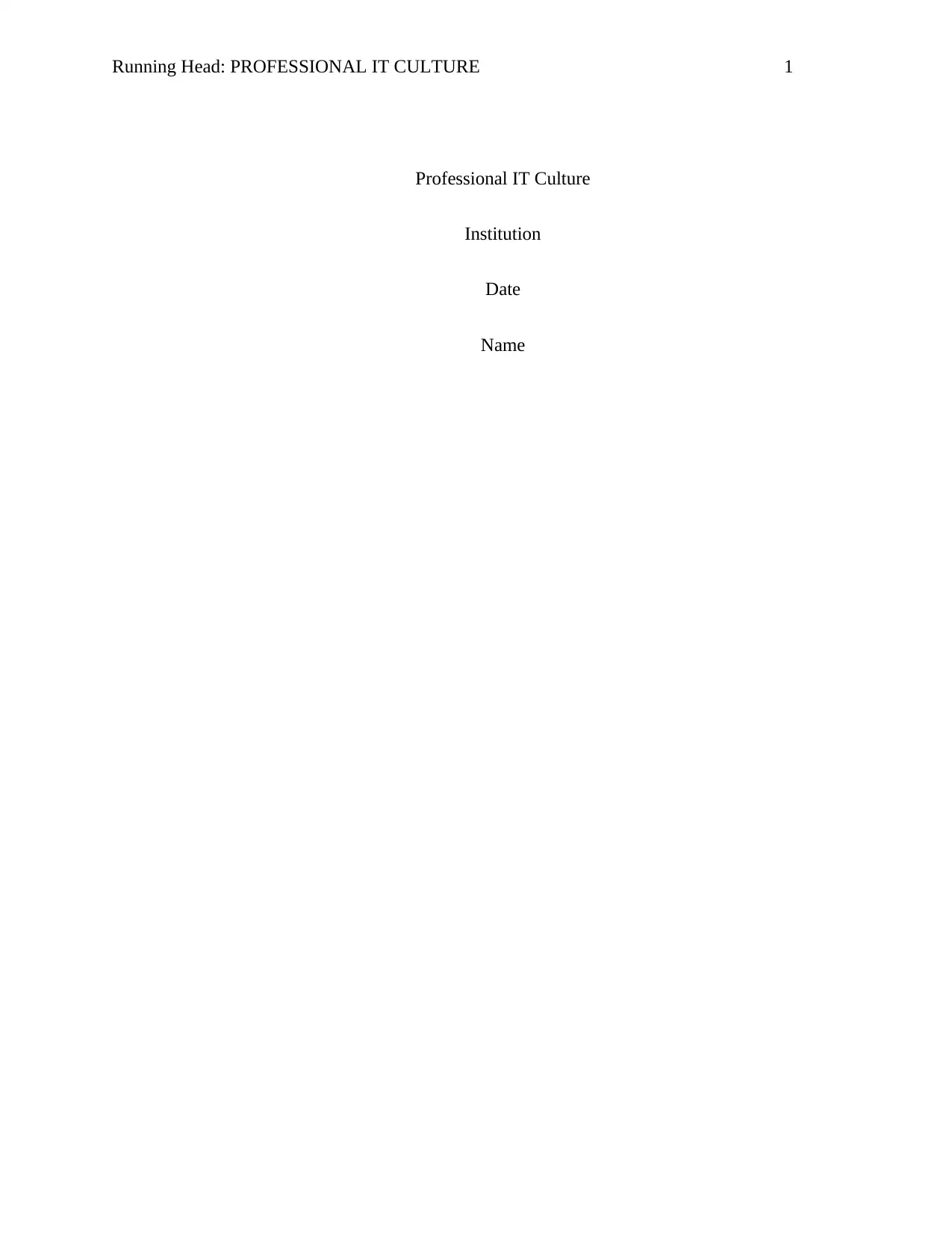
Running Head: PROFESSIONAL IT CULTURE 1
Professional IT Culture
Institution
Date
Name
Professional IT Culture
Institution
Date
Name
Paraphrase This Document
Need a fresh take? Get an instant paraphrase of this document with our AI Paraphraser
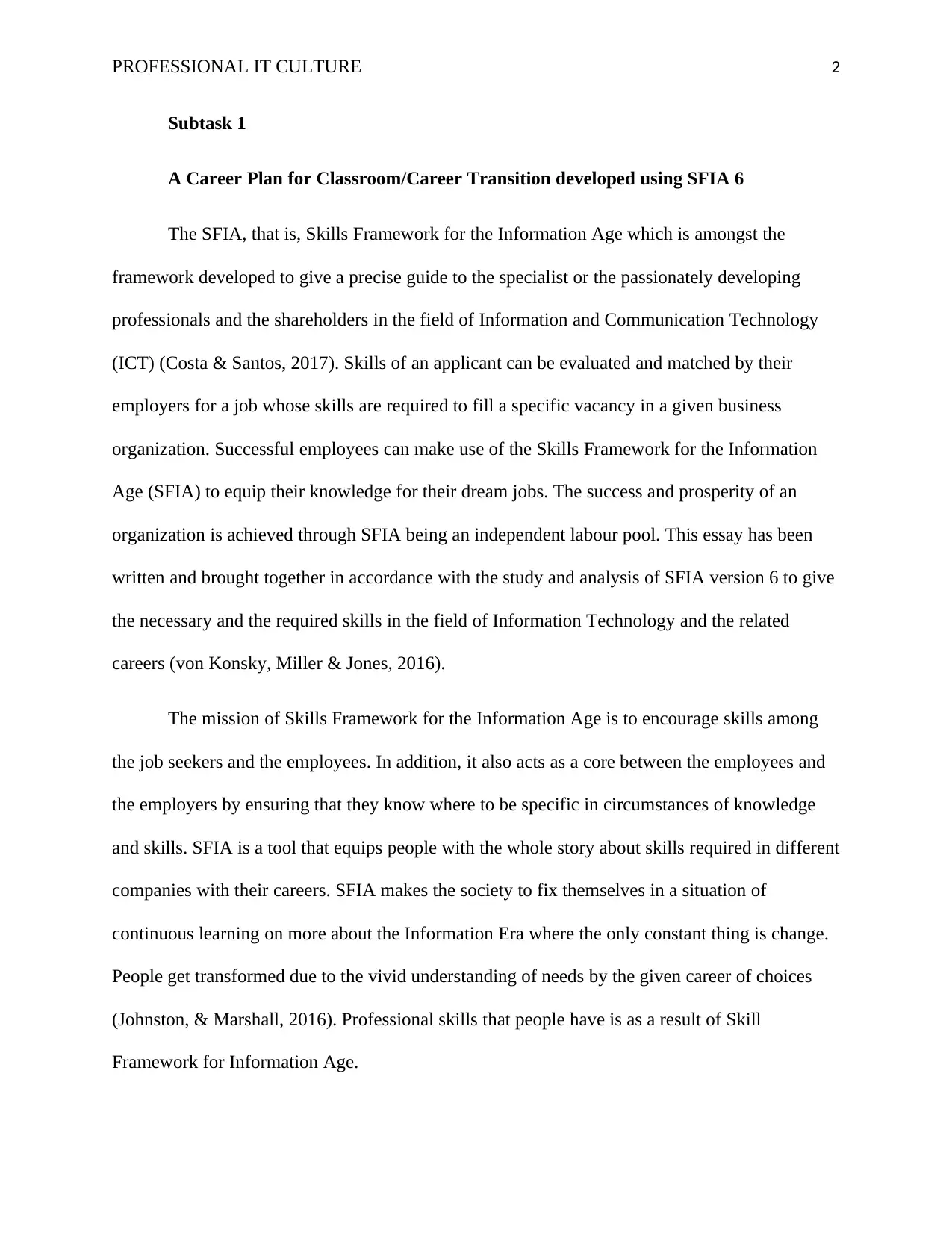
PROFESSIONAL IT CULTURE 2
Subtask 1
A Career Plan for Classroom/Career Transition developed using SFIA 6
The SFIA, that is, Skills Framework for the Information Age which is amongst the
framework developed to give a precise guide to the specialist or the passionately developing
professionals and the shareholders in the field of Information and Communication Technology
(ICT) (Costa & Santos, 2017). Skills of an applicant can be evaluated and matched by their
employers for a job whose skills are required to fill a specific vacancy in a given business
organization. Successful employees can make use of the Skills Framework for the Information
Age (SFIA) to equip their knowledge for their dream jobs. The success and prosperity of an
organization is achieved through SFIA being an independent labour pool. This essay has been
written and brought together in accordance with the study and analysis of SFIA version 6 to give
the necessary and the required skills in the field of Information Technology and the related
careers (von Konsky, Miller & Jones, 2016).
The mission of Skills Framework for the Information Age is to encourage skills among
the job seekers and the employees. In addition, it also acts as a core between the employees and
the employers by ensuring that they know where to be specific in circumstances of knowledge
and skills. SFIA is a tool that equips people with the whole story about skills required in different
companies with their careers. SFIA makes the society to fix themselves in a situation of
continuous learning on more about the Information Era where the only constant thing is change.
People get transformed due to the vivid understanding of needs by the given career of choices
(Johnston, & Marshall, 2016). Professional skills that people have is as a result of Skill
Framework for Information Age.
Subtask 1
A Career Plan for Classroom/Career Transition developed using SFIA 6
The SFIA, that is, Skills Framework for the Information Age which is amongst the
framework developed to give a precise guide to the specialist or the passionately developing
professionals and the shareholders in the field of Information and Communication Technology
(ICT) (Costa & Santos, 2017). Skills of an applicant can be evaluated and matched by their
employers for a job whose skills are required to fill a specific vacancy in a given business
organization. Successful employees can make use of the Skills Framework for the Information
Age (SFIA) to equip their knowledge for their dream jobs. The success and prosperity of an
organization is achieved through SFIA being an independent labour pool. This essay has been
written and brought together in accordance with the study and analysis of SFIA version 6 to give
the necessary and the required skills in the field of Information Technology and the related
careers (von Konsky, Miller & Jones, 2016).
The mission of Skills Framework for the Information Age is to encourage skills among
the job seekers and the employees. In addition, it also acts as a core between the employees and
the employers by ensuring that they know where to be specific in circumstances of knowledge
and skills. SFIA is a tool that equips people with the whole story about skills required in different
companies with their careers. SFIA makes the society to fix themselves in a situation of
continuous learning on more about the Information Era where the only constant thing is change.
People get transformed due to the vivid understanding of needs by the given career of choices
(Johnston, & Marshall, 2016). Professional skills that people have is as a result of Skill
Framework for Information Age.
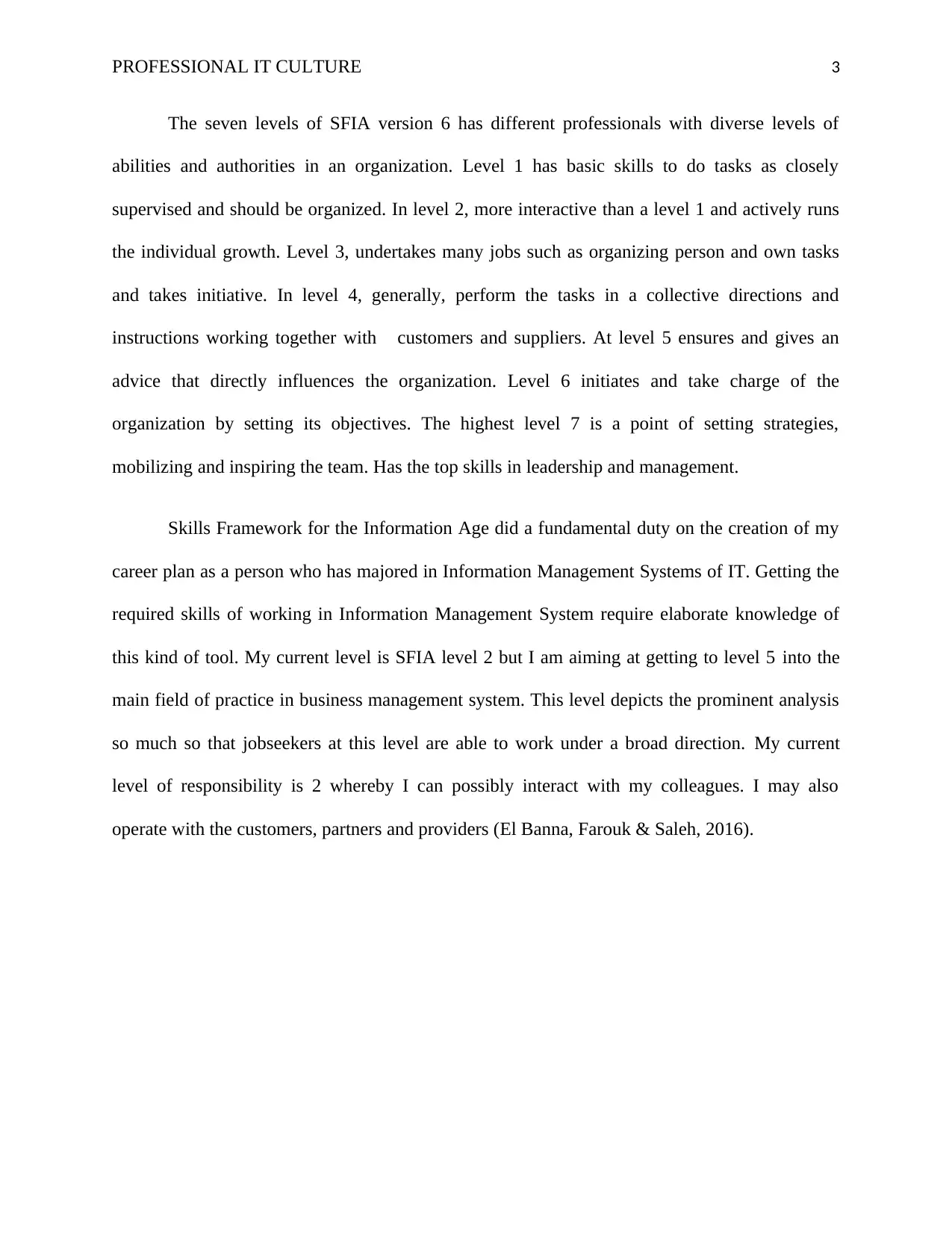
PROFESSIONAL IT CULTURE 3
The seven levels of SFIA version 6 has different professionals with diverse levels of
abilities and authorities in an organization. Level 1 has basic skills to do tasks as closely
supervised and should be organized. In level 2, more interactive than a level 1 and actively runs
the individual growth. Level 3, undertakes many jobs such as organizing person and own tasks
and takes initiative. In level 4, generally, perform the tasks in a collective directions and
instructions working together with customers and suppliers. At level 5 ensures and gives an
advice that directly influences the organization. Level 6 initiates and take charge of the
organization by setting its objectives. The highest level 7 is a point of setting strategies,
mobilizing and inspiring the team. Has the top skills in leadership and management.
Skills Framework for the Information Age did a fundamental duty on the creation of my
career plan as a person who has majored in Information Management Systems of IT. Getting the
required skills of working in Information Management System require elaborate knowledge of
this kind of tool. My current level is SFIA level 2 but I am aiming at getting to level 5 into the
main field of practice in business management system. This level depicts the prominent analysis
so much so that jobseekers at this level are able to work under a broad direction. My current
level of responsibility is 2 whereby I can possibly interact with my colleagues. I may also
operate with the customers, partners and providers (El Banna, Farouk & Saleh, 2016).
The seven levels of SFIA version 6 has different professionals with diverse levels of
abilities and authorities in an organization. Level 1 has basic skills to do tasks as closely
supervised and should be organized. In level 2, more interactive than a level 1 and actively runs
the individual growth. Level 3, undertakes many jobs such as organizing person and own tasks
and takes initiative. In level 4, generally, perform the tasks in a collective directions and
instructions working together with customers and suppliers. At level 5 ensures and gives an
advice that directly influences the organization. Level 6 initiates and take charge of the
organization by setting its objectives. The highest level 7 is a point of setting strategies,
mobilizing and inspiring the team. Has the top skills in leadership and management.
Skills Framework for the Information Age did a fundamental duty on the creation of my
career plan as a person who has majored in Information Management Systems of IT. Getting the
required skills of working in Information Management System require elaborate knowledge of
this kind of tool. My current level is SFIA level 2 but I am aiming at getting to level 5 into the
main field of practice in business management system. This level depicts the prominent analysis
so much so that jobseekers at this level are able to work under a broad direction. My current
level of responsibility is 2 whereby I can possibly interact with my colleagues. I may also
operate with the customers, partners and providers (El Banna, Farouk & Saleh, 2016).
⊘ This is a preview!⊘
Do you want full access?
Subscribe today to unlock all pages.

Trusted by 1+ million students worldwide
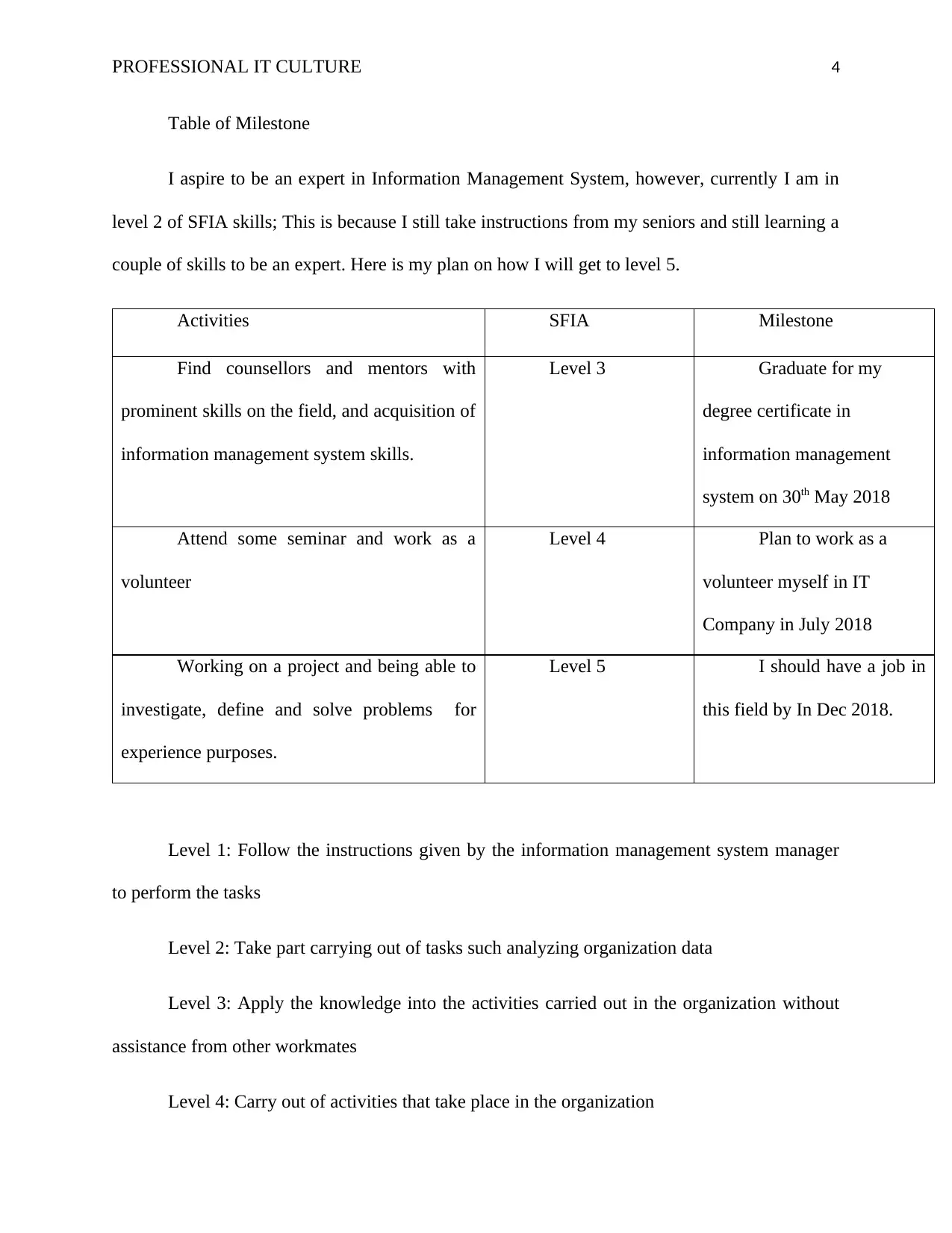
PROFESSIONAL IT CULTURE 4
Table of Milestone
I aspire to be an expert in Information Management System, however, currently I am in
level 2 of SFIA skills; This is because I still take instructions from my seniors and still learning a
couple of skills to be an expert. Here is my plan on how I will get to level 5.
Activities SFIA Milestone
Find counsellors and mentors with
prominent skills on the field, and acquisition of
information management system skills.
Level 3 Graduate for my
degree certificate in
information management
system on 30th May 2018
Attend some seminar and work as a
volunteer
Level 4 Plan to work as a
volunteer myself in IT
Company in July 2018
Working on a project and being able to
investigate, define and solve problems for
experience purposes.
Level 5 I should have a job in
this field by In Dec 2018.
Level 1: Follow the instructions given by the information management system manager
to perform the tasks
Level 2: Take part carrying out of tasks such analyzing organization data
Level 3: Apply the knowledge into the activities carried out in the organization without
assistance from other workmates
Level 4: Carry out of activities that take place in the organization
Table of Milestone
I aspire to be an expert in Information Management System, however, currently I am in
level 2 of SFIA skills; This is because I still take instructions from my seniors and still learning a
couple of skills to be an expert. Here is my plan on how I will get to level 5.
Activities SFIA Milestone
Find counsellors and mentors with
prominent skills on the field, and acquisition of
information management system skills.
Level 3 Graduate for my
degree certificate in
information management
system on 30th May 2018
Attend some seminar and work as a
volunteer
Level 4 Plan to work as a
volunteer myself in IT
Company in July 2018
Working on a project and being able to
investigate, define and solve problems for
experience purposes.
Level 5 I should have a job in
this field by In Dec 2018.
Level 1: Follow the instructions given by the information management system manager
to perform the tasks
Level 2: Take part carrying out of tasks such analyzing organization data
Level 3: Apply the knowledge into the activities carried out in the organization without
assistance from other workmates
Level 4: Carry out of activities that take place in the organization
Paraphrase This Document
Need a fresh take? Get an instant paraphrase of this document with our AI Paraphraser
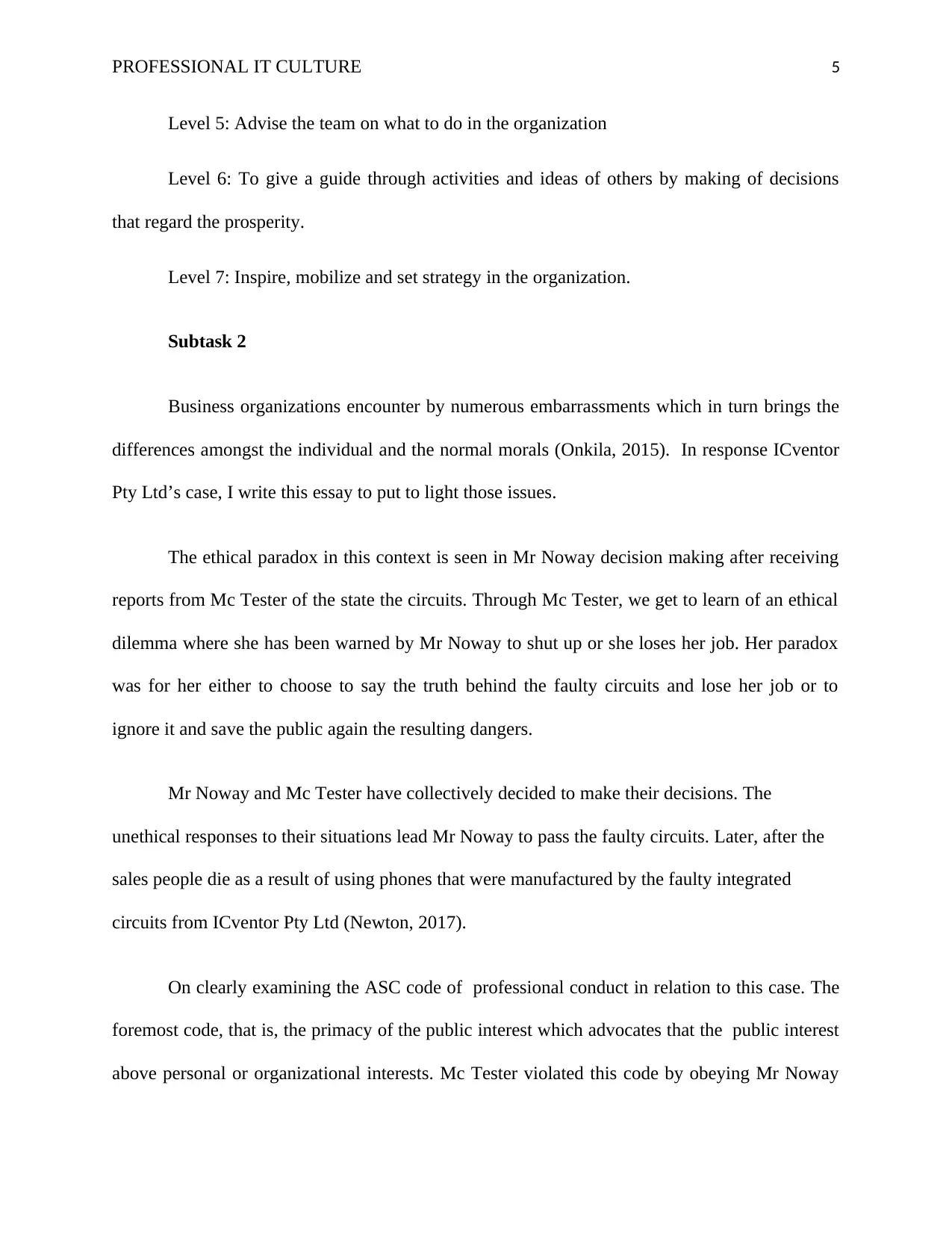
PROFESSIONAL IT CULTURE 5
Level 5: Advise the team on what to do in the organization
Level 6: To give a guide through activities and ideas of others by making of decisions
that regard the prosperity.
Level 7: Inspire, mobilize and set strategy in the organization.
Subtask 2
Business organizations encounter by numerous embarrassments which in turn brings the
differences amongst the individual and the normal morals (Onkila, 2015). In response ICventor
Pty Ltd’s case, I write this essay to put to light those issues.
The ethical paradox in this context is seen in Mr Noway decision making after receiving
reports from Mc Tester of the state the circuits. Through Mc Tester, we get to learn of an ethical
dilemma where she has been warned by Mr Noway to shut up or she loses her job. Her paradox
was for her either to choose to say the truth behind the faulty circuits and lose her job or to
ignore it and save the public again the resulting dangers.
Mr Noway and Mc Tester have collectively decided to make their decisions. The
unethical responses to their situations lead Mr Noway to pass the faulty circuits. Later, after the
sales people die as a result of using phones that were manufactured by the faulty integrated
circuits from ICventor Pty Ltd (Newton, 2017).
On clearly examining the ASC code of professional conduct in relation to this case. The
foremost code, that is, the primacy of the public interest which advocates that the public interest
above personal or organizational interests. Mc Tester violated this code by obeying Mr Noway
Level 5: Advise the team on what to do in the organization
Level 6: To give a guide through activities and ideas of others by making of decisions
that regard the prosperity.
Level 7: Inspire, mobilize and set strategy in the organization.
Subtask 2
Business organizations encounter by numerous embarrassments which in turn brings the
differences amongst the individual and the normal morals (Onkila, 2015). In response ICventor
Pty Ltd’s case, I write this essay to put to light those issues.
The ethical paradox in this context is seen in Mr Noway decision making after receiving
reports from Mc Tester of the state the circuits. Through Mc Tester, we get to learn of an ethical
dilemma where she has been warned by Mr Noway to shut up or she loses her job. Her paradox
was for her either to choose to say the truth behind the faulty circuits and lose her job or to
ignore it and save the public again the resulting dangers.
Mr Noway and Mc Tester have collectively decided to make their decisions. The
unethical responses to their situations lead Mr Noway to pass the faulty circuits. Later, after the
sales people die as a result of using phones that were manufactured by the faulty integrated
circuits from ICventor Pty Ltd (Newton, 2017).
On clearly examining the ASC code of professional conduct in relation to this case. The
foremost code, that is, the primacy of the public interest which advocates that the public interest
above personal or organizational interests. Mc Tester violated this code by obeying Mr Noway
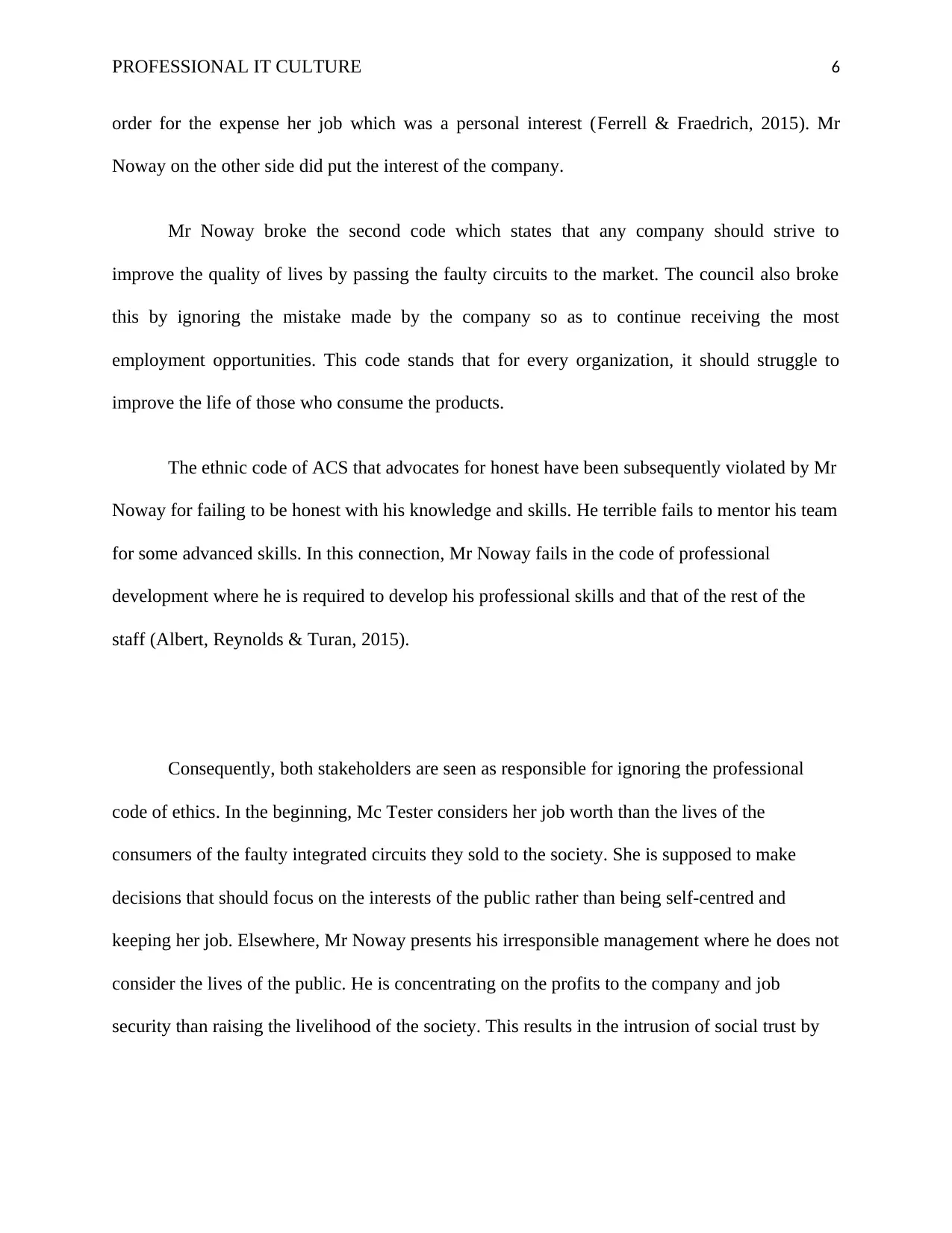
PROFESSIONAL IT CULTURE 6
order for the expense her job which was a personal interest (Ferrell & Fraedrich, 2015). Mr
Noway on the other side did put the interest of the company.
Mr Noway broke the second code which states that any company should strive to
improve the quality of lives by passing the faulty circuits to the market. The council also broke
this by ignoring the mistake made by the company so as to continue receiving the most
employment opportunities. This code stands that for every organization, it should struggle to
improve the life of those who consume the products.
The ethnic code of ACS that advocates for honest have been subsequently violated by Mr
Noway for failing to be honest with his knowledge and skills. He terrible fails to mentor his team
for some advanced skills. In this connection, Mr Noway fails in the code of professional
development where he is required to develop his professional skills and that of the rest of the
staff (Albert, Reynolds & Turan, 2015).
Consequently, both stakeholders are seen as responsible for ignoring the professional
code of ethics. In the beginning, Mc Tester considers her job worth than the lives of the
consumers of the faulty integrated circuits they sold to the society. She is supposed to make
decisions that should focus on the interests of the public rather than being self-centred and
keeping her job. Elsewhere, Mr Noway presents his irresponsible management where he does not
consider the lives of the public. He is concentrating on the profits to the company and job
security than raising the livelihood of the society. This results in the intrusion of social trust by
order for the expense her job which was a personal interest (Ferrell & Fraedrich, 2015). Mr
Noway on the other side did put the interest of the company.
Mr Noway broke the second code which states that any company should strive to
improve the quality of lives by passing the faulty circuits to the market. The council also broke
this by ignoring the mistake made by the company so as to continue receiving the most
employment opportunities. This code stands that for every organization, it should struggle to
improve the life of those who consume the products.
The ethnic code of ACS that advocates for honest have been subsequently violated by Mr
Noway for failing to be honest with his knowledge and skills. He terrible fails to mentor his team
for some advanced skills. In this connection, Mr Noway fails in the code of professional
development where he is required to develop his professional skills and that of the rest of the
staff (Albert, Reynolds & Turan, 2015).
Consequently, both stakeholders are seen as responsible for ignoring the professional
code of ethics. In the beginning, Mc Tester considers her job worth than the lives of the
consumers of the faulty integrated circuits they sold to the society. She is supposed to make
decisions that should focus on the interests of the public rather than being self-centred and
keeping her job. Elsewhere, Mr Noway presents his irresponsible management where he does not
consider the lives of the public. He is concentrating on the profits to the company and job
security than raising the livelihood of the society. This results in the intrusion of social trust by
⊘ This is a preview!⊘
Do you want full access?
Subscribe today to unlock all pages.

Trusted by 1+ million students worldwide
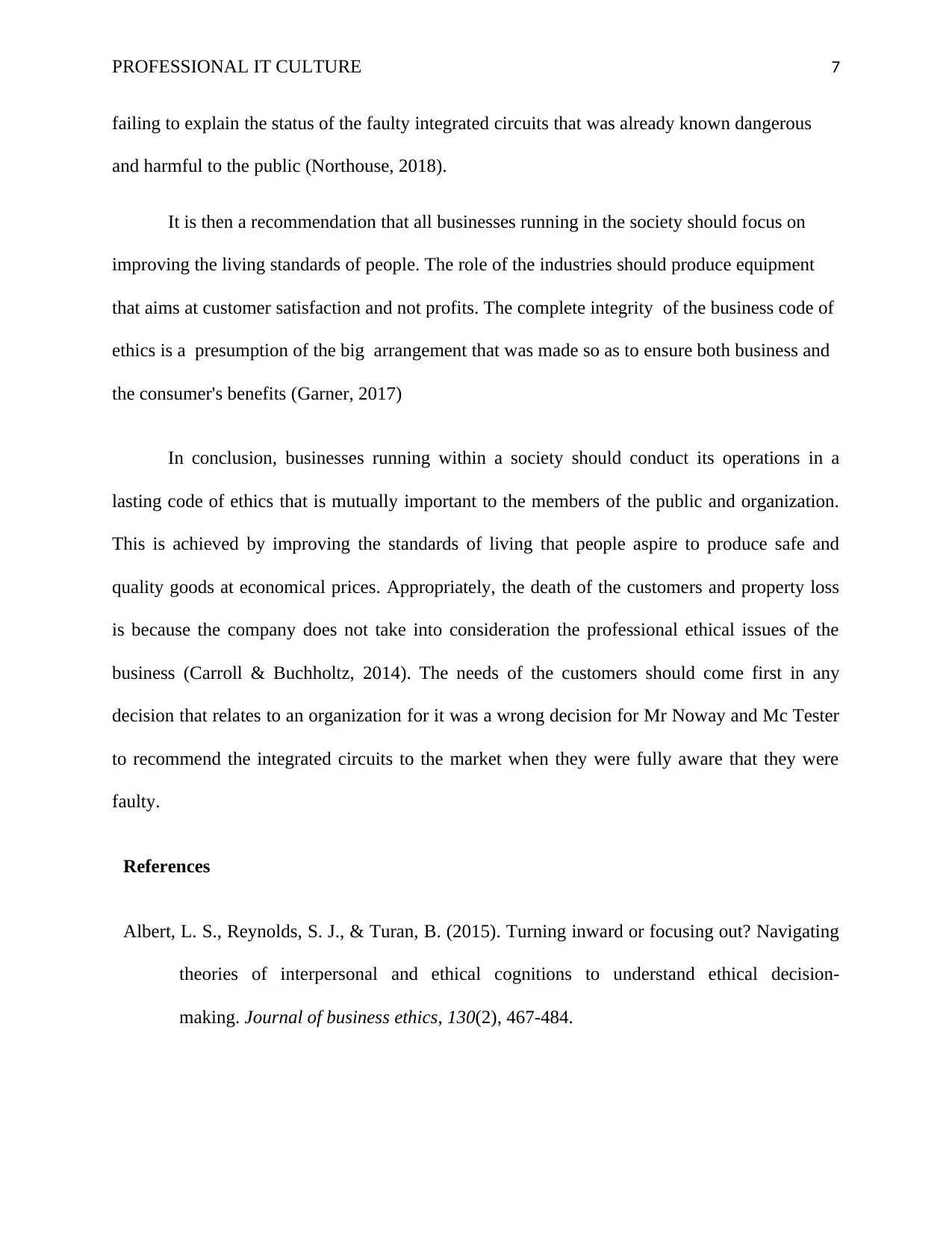
PROFESSIONAL IT CULTURE 7
failing to explain the status of the faulty integrated circuits that was already known dangerous
and harmful to the public (Northouse, 2018).
It is then a recommendation that all businesses running in the society should focus on
improving the living standards of people. The role of the industries should produce equipment
that aims at customer satisfaction and not profits. The complete integrity of the business code of
ethics is a presumption of the big arrangement that was made so as to ensure both business and
the consumer's benefits (Garner, 2017)
In conclusion, businesses running within a society should conduct its operations in a
lasting code of ethics that is mutually important to the members of the public and organization.
This is achieved by improving the standards of living that people aspire to produce safe and
quality goods at economical prices. Appropriately, the death of the customers and property loss
is because the company does not take into consideration the professional ethical issues of the
business (Carroll & Buchholtz, 2014). The needs of the customers should come first in any
decision that relates to an organization for it was a wrong decision for Mr Noway and Mc Tester
to recommend the integrated circuits to the market when they were fully aware that they were
faulty.
References
Albert, L. S., Reynolds, S. J., & Turan, B. (2015). Turning inward or focusing out? Navigating
theories of interpersonal and ethical cognitions to understand ethical decision-
making. Journal of business ethics, 130(2), 467-484.
failing to explain the status of the faulty integrated circuits that was already known dangerous
and harmful to the public (Northouse, 2018).
It is then a recommendation that all businesses running in the society should focus on
improving the living standards of people. The role of the industries should produce equipment
that aims at customer satisfaction and not profits. The complete integrity of the business code of
ethics is a presumption of the big arrangement that was made so as to ensure both business and
the consumer's benefits (Garner, 2017)
In conclusion, businesses running within a society should conduct its operations in a
lasting code of ethics that is mutually important to the members of the public and organization.
This is achieved by improving the standards of living that people aspire to produce safe and
quality goods at economical prices. Appropriately, the death of the customers and property loss
is because the company does not take into consideration the professional ethical issues of the
business (Carroll & Buchholtz, 2014). The needs of the customers should come first in any
decision that relates to an organization for it was a wrong decision for Mr Noway and Mc Tester
to recommend the integrated circuits to the market when they were fully aware that they were
faulty.
References
Albert, L. S., Reynolds, S. J., & Turan, B. (2015). Turning inward or focusing out? Navigating
theories of interpersonal and ethical cognitions to understand ethical decision-
making. Journal of business ethics, 130(2), 467-484.
Paraphrase This Document
Need a fresh take? Get an instant paraphrase of this document with our AI Paraphraser
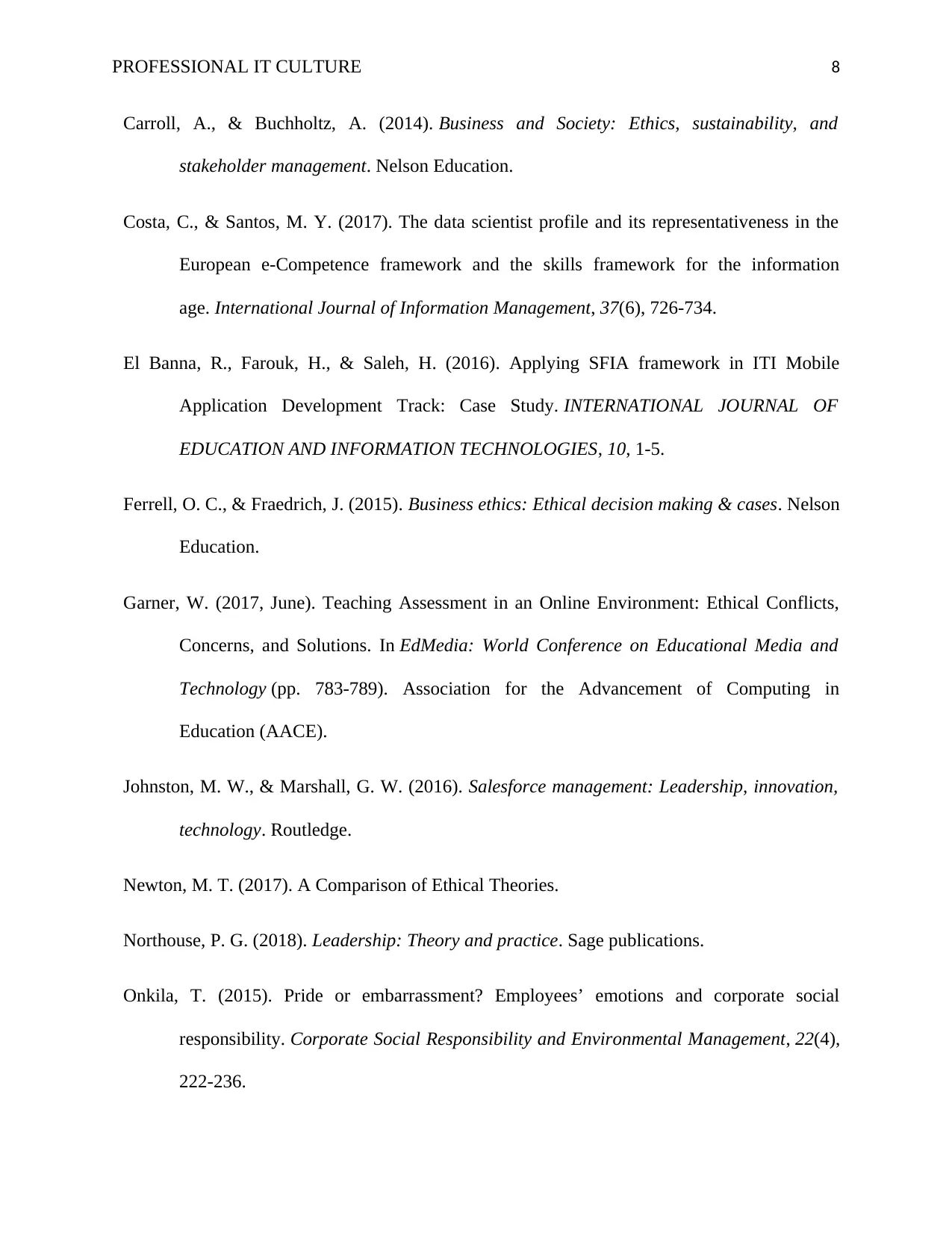
PROFESSIONAL IT CULTURE 8
Carroll, A., & Buchholtz, A. (2014). Business and Society: Ethics, sustainability, and
stakeholder management. Nelson Education.
Costa, C., & Santos, M. Y. (2017). The data scientist profile and its representativeness in the
European e-Competence framework and the skills framework for the information
age. International Journal of Information Management, 37(6), 726-734.
El Banna, R., Farouk, H., & Saleh, H. (2016). Applying SFIA framework in ITI Mobile
Application Development Track: Case Study. INTERNATIONAL JOURNAL OF
EDUCATION AND INFORMATION TECHNOLOGIES, 10, 1-5.
Ferrell, O. C., & Fraedrich, J. (2015). Business ethics: Ethical decision making & cases. Nelson
Education.
Garner, W. (2017, June). Teaching Assessment in an Online Environment: Ethical Conflicts,
Concerns, and Solutions. In EdMedia: World Conference on Educational Media and
Technology (pp. 783-789). Association for the Advancement of Computing in
Education (AACE).
Johnston, M. W., & Marshall, G. W. (2016). Salesforce management: Leadership, innovation,
technology. Routledge.
Newton, M. T. (2017). A Comparison of Ethical Theories.
Northouse, P. G. (2018). Leadership: Theory and practice. Sage publications.
Onkila, T. (2015). Pride or embarrassment? Employees’ emotions and corporate social
responsibility. Corporate Social Responsibility and Environmental Management, 22(4),
222-236.
Carroll, A., & Buchholtz, A. (2014). Business and Society: Ethics, sustainability, and
stakeholder management. Nelson Education.
Costa, C., & Santos, M. Y. (2017). The data scientist profile and its representativeness in the
European e-Competence framework and the skills framework for the information
age. International Journal of Information Management, 37(6), 726-734.
El Banna, R., Farouk, H., & Saleh, H. (2016). Applying SFIA framework in ITI Mobile
Application Development Track: Case Study. INTERNATIONAL JOURNAL OF
EDUCATION AND INFORMATION TECHNOLOGIES, 10, 1-5.
Ferrell, O. C., & Fraedrich, J. (2015). Business ethics: Ethical decision making & cases. Nelson
Education.
Garner, W. (2017, June). Teaching Assessment in an Online Environment: Ethical Conflicts,
Concerns, and Solutions. In EdMedia: World Conference on Educational Media and
Technology (pp. 783-789). Association for the Advancement of Computing in
Education (AACE).
Johnston, M. W., & Marshall, G. W. (2016). Salesforce management: Leadership, innovation,
technology. Routledge.
Newton, M. T. (2017). A Comparison of Ethical Theories.
Northouse, P. G. (2018). Leadership: Theory and practice. Sage publications.
Onkila, T. (2015). Pride or embarrassment? Employees’ emotions and corporate social
responsibility. Corporate Social Responsibility and Environmental Management, 22(4),
222-236.
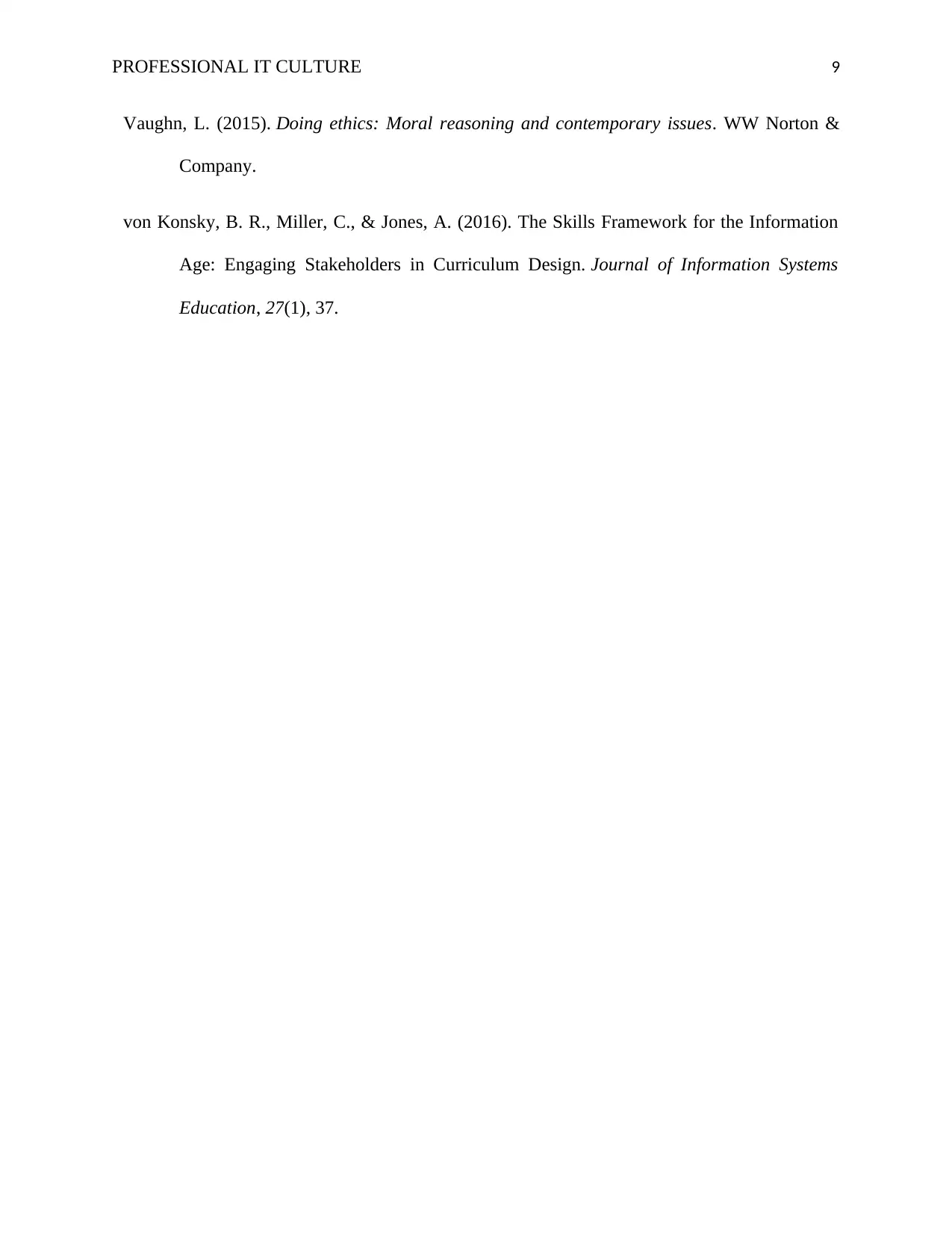
PROFESSIONAL IT CULTURE 9
Vaughn, L. (2015). Doing ethics: Moral reasoning and contemporary issues. WW Norton &
Company.
von Konsky, B. R., Miller, C., & Jones, A. (2016). The Skills Framework for the Information
Age: Engaging Stakeholders in Curriculum Design. Journal of Information Systems
Education, 27(1), 37.
Vaughn, L. (2015). Doing ethics: Moral reasoning and contemporary issues. WW Norton &
Company.
von Konsky, B. R., Miller, C., & Jones, A. (2016). The Skills Framework for the Information
Age: Engaging Stakeholders in Curriculum Design. Journal of Information Systems
Education, 27(1), 37.
⊘ This is a preview!⊘
Do you want full access?
Subscribe today to unlock all pages.

Trusted by 1+ million students worldwide
1 out of 9
Related Documents
Your All-in-One AI-Powered Toolkit for Academic Success.
+13062052269
info@desklib.com
Available 24*7 on WhatsApp / Email
![[object Object]](/_next/static/media/star-bottom.7253800d.svg)
Unlock your academic potential
Copyright © 2020–2025 A2Z Services. All Rights Reserved. Developed and managed by ZUCOL.





